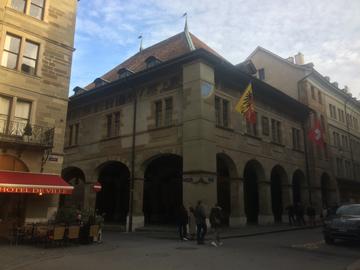Project Books: The Alpine Vault of Europe
In front of the Ancien Arsenal of the city of Geneva, in the building which holds the city’s archives, one encounters a quintet of cannon, placed defiantly before a trio of mosaics by the early 20th-century artist Alexandre Cingria (a graduate of the École des Beaux-Arts in Geneva) which depict important events in Genevan history. The cannon had been used to defend the city against attack from its one-time overlord, and subsequent bitter enemy, the staunchly Catholic dukes of Savoy; one of the mosaics displays the welcome granted by city officials and the wider populace to Protestant refugees seeking a new home as they fled religious persecution.

Early modern Geneva was a city of refugees. The city was filled with émigrés, chiefly from France and Italy, but also from Germany, Switzerland, and further afield, who brought their artisanal trades to Geneva and thus conferred prosperity upon their sanctuary. Renowned as the religious and cultural motherland of Calvinism, this tiny alpine republic, nestled at the foot of Lac Léman and within a stone’s throw of the frontiers with Savoie and France, might not appear at first glance to have occupied a prominent place in the warmaking machinery of Europe’s belligerent powers.
But Geneva, or to be more accurate, its merchant bourgeoisie, plunged enthusiastically into the international money markets from the late seventeenth century onwards. As monarchs such as Louis XIV struggled to fund their wars through reliance on domestic taxation, they turned instead to international networks of merchants and financiers with tentacles stretching between Lyon, Amsterdam, Genoa, London, Hamburg, Madrid and many other European metropoles. The extensive exodus of French Protestants to Geneva and the Pays de Vaud – a phenomenon which dated back to the wars of religion in mid-sixteenth-century France – increased the city’s population but also placed pressure upon food supply. Throughout the period, Geneva depended on supplies of grain from France and Germany to feed its people, and this dependence could be – and frequently was – weaponised by the city’s neighbours to try to force co-operation with their demands.

Geneva was a vital link in a chain of financial hubs in early modern Europe. Branches of mercantile dynasties from the republic, established in trading centres throughout the continent, looked upon Geneva as the city that had saved them from persecution at the hands of a zealously Catholic French monarchy. Members of the same families controlled the political scene, and power was increasingly concentrated in the hands of those who had accrued large fortunes through international trade, particularly in silk. This monopolisation of authority gave rise to political unrest. Genevan society experienced three significant insurrections – 1707, 1738, and 1782 – before the city’s political structures were finally and definitively uprooted in the febrile winter of 1792-93, with stimulation from the revolutionary government in neighbouring France. French troops ultimately annexed the republic in 1798, creating the territorially enormous (and politically unwieldy) Département de Léman, with Geneva as its capital. For 15 years Geneva was part of France, and as such, lost its cherished independence, until liberation by the Austrians in 1813. At the Congress of Vienna, Geneva gained significantly in territorial terms, and finally became a canton of the Swiss Confederation, which was similarly emerging from French domination in the Napoleonic era.
Geneva’s lack of subjection to the dictates of foreign powers had played a prominent part in ensuring the rise of its banking class. This book shows how Genevan bankers acquired more and more importance in the financing of warfare, from the late seventeenth century onwards, when firms such as Saladin & Buisson and Lullin & Nicolas lent heavily to both the House of Savoy and Louis XIV. It explores the careers of individuals such as Isaac Thellusson and Jacques Necker, whose skill and acuity in financial transactions led to their establishment as essential links between Geneva and the French finance and war ministries before 1789. The book also explores aspects of Geneva’s significance as a hub for the movement of contraband, both in trade goods and in war matériel, as well as intelligence-gathering and the ethicalness of involvement in financing war.
Work on the manuscript of this book will conclude in December, and I hope that it will be published in 2024. Next year marks a century since the Geneva Protocol, an attempt to establish a mediatory body for international disputes, was first presented to the League of Nations by the British and French governments. Despite its reputation as “the city of peace”, The Alpine Vault of Europe will show that Genevan involvement in war was both self-serving and deeply ingrained.
John Condren was formerly Research Associate for the European Fiscal-Military System project, and is now Assistant Professor in History at the University of Nottingham.


